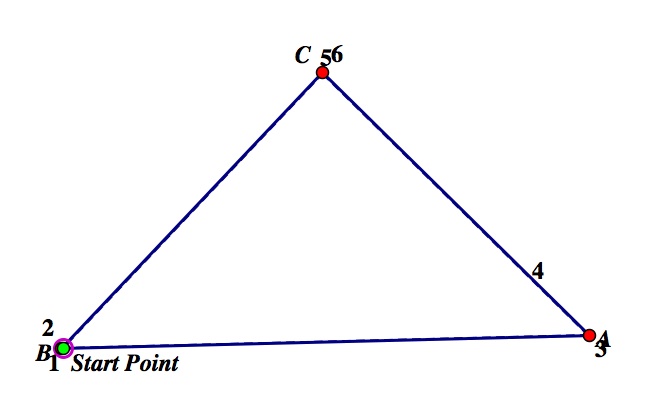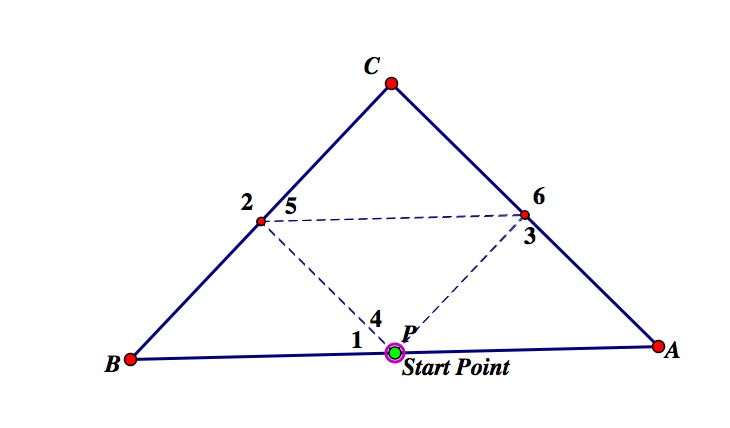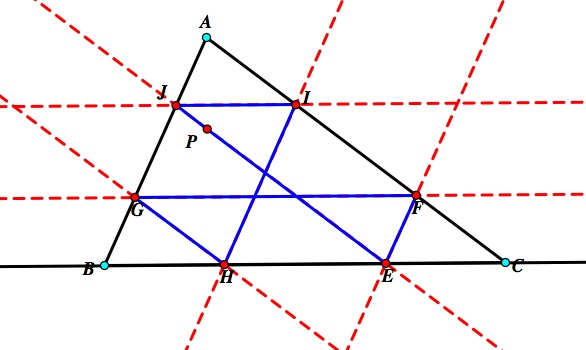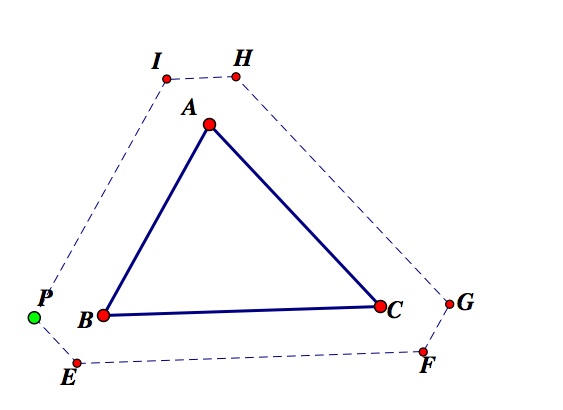

Problem: Barney is in the triangular room shown here. He walks from a point on BC parallel to AC. When he reaches AB, he turns and walks parallel to BC. When he reaches AC, he turns and walks parallel to AB. Prove that Barney will eventually return to his starting point. How many times will Barney reach a wall before returning to his starting point? Explore and discuss for various starting points on line BC, including points exterior to segment BC. Discuss and prove any mathematical conjectures you find in the situation.
Write up:
To animate the starting point of the problem discussed above, please see the gsp file attached here. An image of the bouncing barney situation is shown below:

Does Barney always end up back at the starting point? From the animation, it appears that he does, but we cannot really be sure without some sort of mathematical proof. Also how far does Barney travel when bouncing around?
There are 6 different cases that I want to look at. Those are listed below:
Case 1: Barney starts at one of the triangle's vertices.
Case 2: Barney begins on a midpoint of one of the sides.
Case 3: Barney begins at any point ON one of the sides.
Case 4: Barney begins his journey at the centroid
Case 5: Barney begins at an arbitrary point within the triangle.
Case 6: Barney starts at a point outside the triangle, but on the line extending from the segments of the side of the triangle.
Case 1: Barney begins at a vertex.

In the image above, you can see that Barney (which I have labeled in such an original manner, "start point") begins at vertex B. The case will be the same at any vertex.
Since Barney needs to walk a parallel line to one of the sides of the triangle, he needs to choose either to walk on line BC or line AB (if we consider that being at a vertex means that he is contained in the triangle and can't go outside of it). Thus, it does not matter which way. Let's say he chooses to walk along Line BA. Then when he reaches A, the only choice is for him to walk on Line AC, since he can't go outside the triangle, and he can't walk backwards. The same situation occurs when he reaches point C. The Only choice is for him to walk on line CB. Thus, he has returned to his starting point, point B. This follows for any starting vertex. Also note that the length of his journey is the perimeter of the triangle.
Case 2: Barney begins at a midpoint of one of the sides. See image below with midpoint labeled P.

So here Barney starts at point P. He has two options. He could either walk parallel to line BC or parallel to line AC. Let's say he chooses the segment parallel to AC. Thus, he ends up at point 2. When he gets there, he has no choice but to walk parallel to line AB and ends up at point 6. Finally, he has no choice but to walk parallel to line CB and end up back at point P, which is the starting point. It appears that he has hit all the midpoints and that he has walked one half of the perimeter of triange ABC. Is this true?
Justification: Since the segment "P2" is parallel to segment "AC" and "P3" is parallel to "BC", it seems that Quadrilateral P2C3 is a parallelogram. This implies that P2 = C3. In a similar fashion we can form parallelogram P23A leading to P2 = 3A. Using transitivity, we have that C3 = 3A, and thus point 3 is the midpoint of the line CA. Since P2 = C3 = 3A, the length of P2 is one half the length of CA. The same is true for line 23 and line 3A. Thus, Length(P2)+Lenght(23)+Length(3P) = 1/2*Length(AC)+1/2*Length(AB)+1/2*Length(BC) as desired.
This also means that all the inner triangles are congruent and also similar to triangle ABC!
Case 3: Barney starts at any Arbitrary point on the triangle other than vertices or midpoints.

This time Barney hits the wall 6 times instead of 3. Does this make a difference? How long is this path?
First we observe that Line 23 is parallel to BC and Line 34 is parallel to BA, of course. Thus B23F is a parallelogram. So 23 = B4 and B2 = 34. In the same way, using parallelograms, 12=3C, 1C = 23, 56 = 4C, A5 = 34, 54 = A3, 54=6C, and so on...
Thus, The distance that barney traveled is 12+23+34+45+56+61 = (A3+3C)+(C4+4B)+(B2+2A) = AC+CB+BA = perimeter of the triangle. Thus, Barney traveled the same distance as the perimeter of the triangle.
The facts above can also be used to point out a number of similar and congruent triangles that are within the big triangle, such as triangle B21 = Triangle C34. I will not point them out here as that could get rather redundant. It is more important to move on to the other cases.
Case 4: Barney in the triangle. Let's first look at when Barney is at the centroid.

In the image, P is the centroid, and the red marks the path taken by Barney. As you can see it is similar to the case of the midpoint in that there are only 3 segments needed. VUP actually provides another path that could have been taken. Any way you slice it, though, you end up with 3 segments. How long is this path? Well it seems like it needs to be less than the path taken when Barney was on the midpoint. Let's prove this.
Since P is the centroid, we have the ratios AP/PL, CP/PN and BP/PM all being 2/1 (I actually proved this in a previous write-up, assignment 4). Triangles APF and ALC are similar due to Angle-Angle-Angle. Thus Ap/AL, AF/AC and PF/LC all have a 2/3 ratio. So we have FC/AC = (AC-AF)/AC = (3/2)/3 = 1/3/
We also know that EF is parallel to AB and that CEF is similar to CAB due to Angle-Angle-Angle. Thus, again EF/AB = CF/AC = 1/3which implies that EF = 1/3*AB.
PF/LC = 2/3 because APF and ALC are similar, and UP/BL = AP/AL = 2/3 because AUP and ABL are similar. Thus UP=2/3*BL, PF =2/3*LC and BL = LC.
So because AUF is similar to ABC, AF/AC= UF/BC = 2/3 and UF = 2/3*BC. Thus, PF = 1/2*UF = 1/2*(2/3*BC) = 1/3*BC.
We do the same process to find that PE = 1/3*AC ad so PE+EF+FP = 1/3*AC + 1/3*AB + 1/3*BC which means that Barney traveled one-third of the perimeter in his trip and we have found the length of his trip!
It looks like if Barney wants to travel a short distance, he should start at the centroid! Let's see if we can find an even more convenient route for him...
Case 5: Barney starts at an arbitrary point (inside of the triangle).
I found that the case of the orthocenter and an arbitrary point that isn't the centroid work just the same, so I will prove the arbitrary point using the orthocenter in this case.

Barney's path is shown in the Blue, where Barney goes from P to E to start, and so on.
Note that Barney still will hit wall or bounce six times before he goes back to the point where he starts, except that the first and last "leg" of the track can be seen as one path divided into two parts with P lying on the path. It is also true that the path in which Barney travels is different than in Case 3 (when P was an arbitrary point on a side), the distance he travels is exactly the same as that in Case 3. Both distances equal the perimeter of triangle ABC.
How can we be sure? Well, I am not going to repeat the same proof here, but the methodology from Case 3 works in the same fashion for this case. For instance, CE = JI, etc. The truly adventurous can try to reproduce this on their own, but for time purposes I will omit here so that I can get to the two remaining cases.
Case 6: Barney starts at a point outside the triangle, but on the line extending from the segments of the side of the triangle.

Follow the dotted line to see the path that Barney takes. Once again he ends up back at the starting position. How long is his path though? Let's try to find out:
We will follow much in the same way that we have in previous cases. First we see that EF is parallel to BC and PE is parallel to AC so PEFC is a parallelogram, resulting in the length of PE equaling the length of CF as well as the length of PC equaling the length of EF.
Consequently, using the same logic, FG = BE, EF = BG, PE = AI, PI = AE, PB = HI, PI = BH, HG = CI, HI = CG, AH = FG, and HG = AF.
All of this leads us to concluding that PI = AE = BH, EF = PC=BG, HG = AF = CI. Since AE = BH, AB+BE = AB+ BH, so BE = AH. Thus by the same token, AI = CF and PB = CG.
Hence, the distance traveled = PE + EF+ FG + GH + HI + IP = AI + PC + AH + AF + CG + AE= (AI+AF) + (PC+CG) + (AH+AE) = IF+PG+H.
However, we also have IF+PG+HE = (AC+CF+AI)+(BC+PB+CG)+(AB+BE+AH).
From above, we know that that huge long expression can be reduced to AC+2*AI+BC+2CG+AB+2*AH = (AC+BC+AB) + 2*(AI+AH+CG)
This implies that the distance traveled is equal to the perimeter of triangle ABC plus two times the perimeter of Triangle AHI. It should be noted that any of the three small triangles outside of ABC could be used for the second expression.
It should be noted that one may want to investigate what happens when the Barney starts at an arbitrary point outside of the triangle other than the lines above. I will leave this for others to try in the future!
General Conjectures from the explorations made here:
1. Given that Barney follows the rules that are supplied, he will always end up back at the starting point no matter where he starts.
2. Barney will hit the wall either 6 or 2 times, decided by where exactly he starts his journey.
3. The paths that he makes create a series of congruent and similar triangles within or outside the starting triangle, useful in figuring out the distance traveled by Barney.
4. Like the path itself, the distance traveled depends on where he starts and the path he travels. In almost all cases when Barney starts in the triangle, the distance he travels equals the perimeter of the triangle. One exception occurs when he starts at the centroid, which has him traveling 1/3 of the perimeter of the triangle. The other exception occurs when he starts at a midpoint of one of the sides; The length of the travel in this case is 1/2 of the perimeter of the triangle.
5. Sometimes, he has to travel more than the perimeter of the triangle room. When he starts outside of the triangle, but on the line extending from the sides,the distance that Barney has to travel in order to go back to his starting point is longer than the perimeter of the triangle room. Quite obviously, the farther away Barney is from the closest vertex of the triangle room when he starts bouncing, the longer he has to travel in order to go back to his original starting point. However, the distance is always a function of the sum of the perimeter of the original triangle and double one of the triangles created on the outside of the original trangle.
My advice for Bouncing Barney is to become more like Leaping Larry and Leap over the sides of the triangle!
The End.